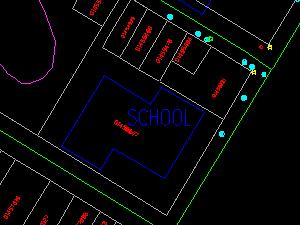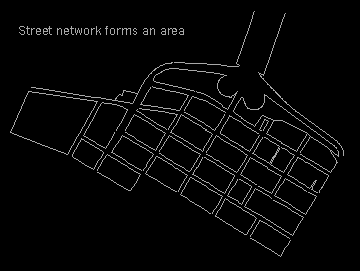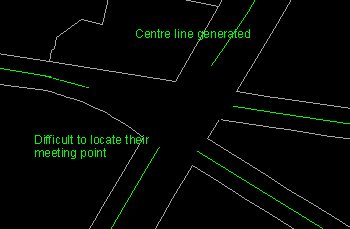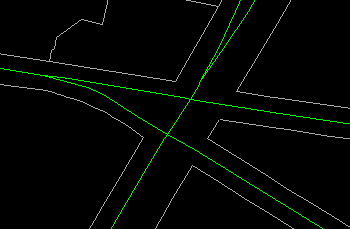![]()
Other than geographic features, there are also cartographic features, which do not represent real world objects but are used purely for cartographic presentations. Annotation labels to show the name of the river or the name of a street are examples.
Geographic features might cover areas such as the school building in the map below. They might follow lines such as the edge of the pavement. They might be so small at the scale of representation that they simply occupy points such as the utility post in front of the school.

(289037, 739863), 1:850
Whether a feature should be represented by an area, a line, or a point is a matter of scale and compatibility. Scale is related to the level of detail appropriate for the application, and the representation must be compatible with the way a GIS stores and manipulates the features.
All geographic features occupy areas in the real world. They are reduced to lines or points because of the need to avoid unnecessary details in the database. A street network includes the surface of the road and hence is an area feature at large scale. At small scale, the streets would be too narrow on the display and would collapse to single lines.

Even at large scale, we might still want to represent streets using single
lines because it is more convenient for a GIS to operate on them. For
example, it is difficult for a GIS to automatically compute the length of
a street using the area representation. In order to do this, the software
must first locate the centre of a street and then measure the length along
it. This is not too difficult if it is nicely bounded by two lines,
although this process could be time consuming on a large database. The
difficulty arises at an intersection where it is difficult to determine
where the centre lines meet.
(288249,
740452), 1:1900

One way of getting around this problem is to create a network of centre lines manually and store it along with the double-sided streets.

The combination of the two representations gives the user two perspectives of the street network. The area perspective is suitable for applications that must view the streets as covering an area, and this perspective can be used to compute, for example, the width and surface area of the streets. The line perspective is suitable for applications that must view the streets as connectors. It is the more appropriate perspective for measuring lengths and finding the shortest route between two points.
It would have been ideal if a GIS could automatically create and switch from one representation to another depending on the operations being performed. GIS are performing such conversions to some extent. However, the users must still make the major decision of which representations to incorporate when creating a GIS database. A wrong choice can later affect the performance of the system.
![]()